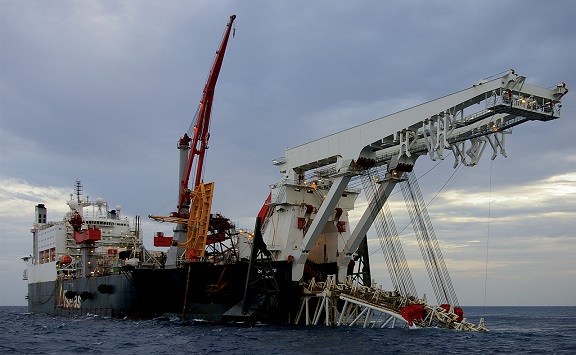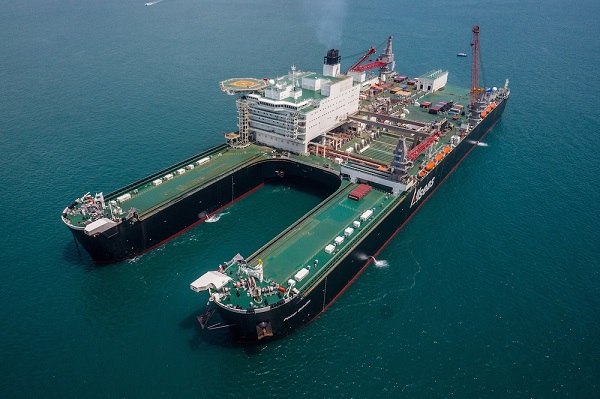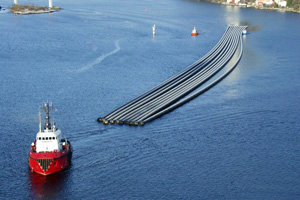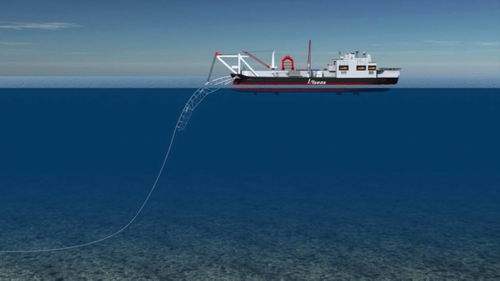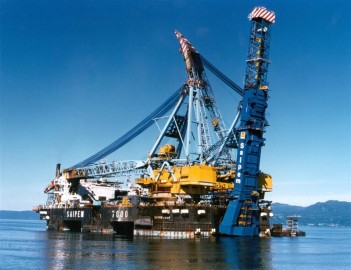 |
 |
||
| Offshore Fleet | ||||||||||||
| Pipelaying Vessel | ||||||||||||
Pipelaying vessel (PLV) or pipelay vessel is a specialized floating facility for submerged pipeline laying. It is widely used in offshore fields development for laying pipelines up to 1,420 millimeters in diameter down to 2,500 meters depth. Submerged pipelines can be constructed on pipelaying vessels by stovepipe welding of pipe sections stored on the deck or by the reel method by which the pipeline produced onshore is wound onto reels beforehand. Winding onto the reel is possible for up to 90 kilometers of 100 to 400 millimeters diameter pipes. During pipeline laying the reel constantly rotates and the pipe is laid down to a 300 meter depth at a speed of up to 4 kilometers per hour. During lowering of the pipeline prepared on a deck a special device (a stinger) supports it to prevent from major bends when moving it from the vessel. The maintenance of all pipelaying vessel systems and welding equipment is performed by a computer (sea depth, wave and wind speeds are taken into account; pipelaying vessel stability is ensured).
Solitaire vessel
As a rule, several vessels participate in the process of pipe laying. Special barges continuously supply pipes to a pipelaying vessel, which is preceded by a vessel monitoring the seabed. The supplied pipes are unloaded on storage sites located directly on the deck of the pipelaying vessel. They should have a stock of pipes for 12 hours of work. Special conveyor is installed on the pipelaying vessel, which receives pipes that are welded here as well. Each welded joint is then ultrasonically tested for defects. Anticorrosion coating is applied to all joints after welding. Welded pipes are moving over the conveyor towards the aft. Stinger, a special boom, immersed in the water at an angle, over which the pipes are gradually lowered onto the seabed, is located here. It defines the required deflection of the top part of the gas pipeline, which prevents metal deformation.
Pieter Schelte, the largest pipelay vessel in our days
There are three main ways that subsea pipe is laid -- S-lay, J-lay and tow-in -- and the pipelay vessel is integral to the success of the installation. Buoyancy affects the pipelay process, both in positive and negative ways. In the water, the pipe weighs less if it is filled with air, which puts less stress on the pipelay barge. But once in place on the sea bed, the pipe requires a downward force to remain in place. This can be provided by the weight of the oil passing through the pipeline, but gas does not weigh enough to keep the pipe from drifting across the seafloor. In shallow-water scenarios, concrete is poured over the pipe to keep it in place, while in deepwater situations, the amount of insulation and the thickness required to ward of hydrostatic pressure is usually enough to keep the line in place. Tow-In Pipeline Installation While jumpers are typically short enough to be installed in sections by ROVs, flowlines and pipelines are usually long enough to require a different type of installation, whether that is tow-in, S-lay or J-lay. Tow-in installation is just what it sounds like; here, the pipe is suspended in the water via buoyancy modules, and one or two tug boats tow the pipe into place. Once on location, the buoyancy modules are removed or flooded with water, and the pipe floats to the seafloor.
Surface Tow Pipeline Installation
There are four main forms of tow-in pipeline installation. The first, the surface tow involves towing the pipeline on top of the water. In this method, a tug tows the pipe on top of the water, and buoyancy modules help to keep it on the water's surface. Off-bottom tow uses buoyancy modules and chains for added weight, working against each other to keep the pipe just above the sea bed. When on location, the buoyancy modules are removed, and the pipe settles to the seafloor.
S-Lay Pipeline Installation The term S-lay refers to the shape that the pipe forms between the vessel and the seabed as it is laid. The method is characterised by its fast installation process and its workability over a large range of water depths.
S-Lay Pipeline Installation
On board the pipelay vessel, pipe joints are assembled in a horizontal working plane (the firing line). Pipe joints are welded together, inspected and then coated as they move through the various firing line work stations. As welding progresses, the pipeline is gradually lowered towards the seabed behind the vessel. During pipelay, the curvature of the upper section of the pipeline (the overbend) is controlled by the stinger, a steel structure with rollers protruding from the end of the firing line to prevent pipe buckling (failure). The curvature in the lower section (the sagbend) of the pipeline is controlled by pipe tensioners, caterpillar tracks that clamp the pipe. The amount of tension is one of the most important limiting factors in the capabilities of an S-lay vessel. After a pipeline has been laid, and the system has been tested and commissioned, the client can transport oil or gas through it.
J-Lay Pipeline Installation J-lay is used to install subsea rigid pipelines in deep water. With a J-lay system, pipe stalks, consisting of up to six pipes with a total length of 72m, are upended and welded to the seagoing pipe in a near vertical ramp. The ramp angle is adjusted so that it is in line with the pipe catenary hanging to the seabed to keep bending of the pipe to a minimum. The J-lay method is very suitable for deepwater pipelaying because the pipe leaves the lay system in an almost vertical position and the pipeline is only bent (once) during installation (at the seabed). This reduced amount of bending is beneficial for installing pipelines that are sensitive to fatigue. Compared to other lay methods, J-lay has a relatively low production rate due to the single position welding of the pipe. The J-lay method is less suitable for shallow waters as this requires a departure angle close to horizontal.
J-Lay Pipeline Installation
Pipelay 3D animation Used sources: Gazprom, RigZone, AllSeas, Huisman |
||||||||||||
| « Back to all Offshore Fleet | ||||||||||||

|
|
 |
|
|
||||||||||||
